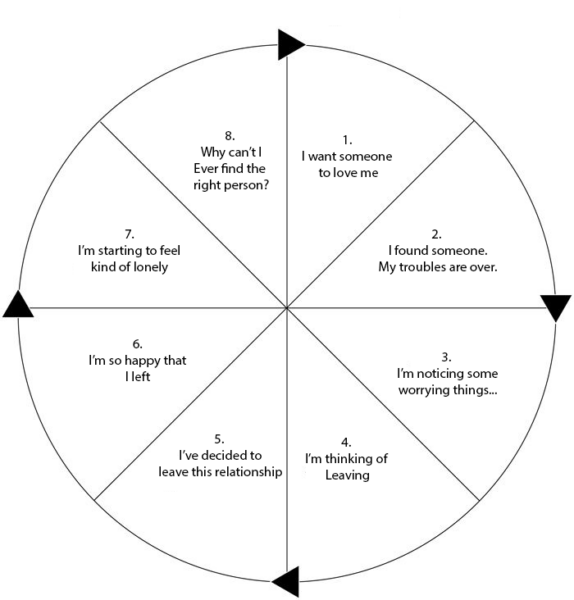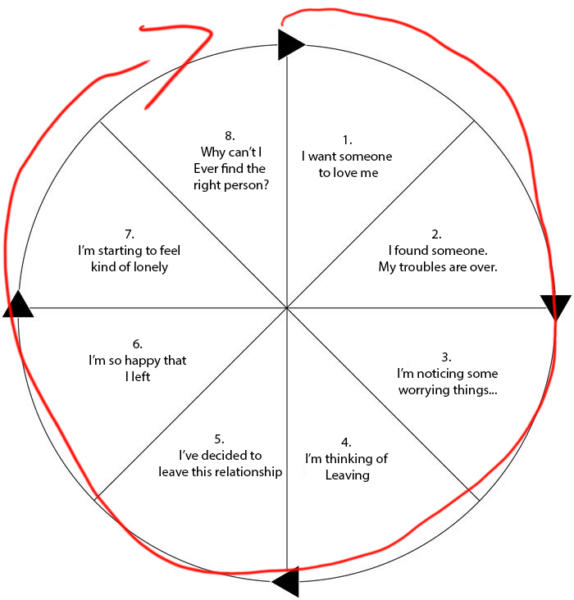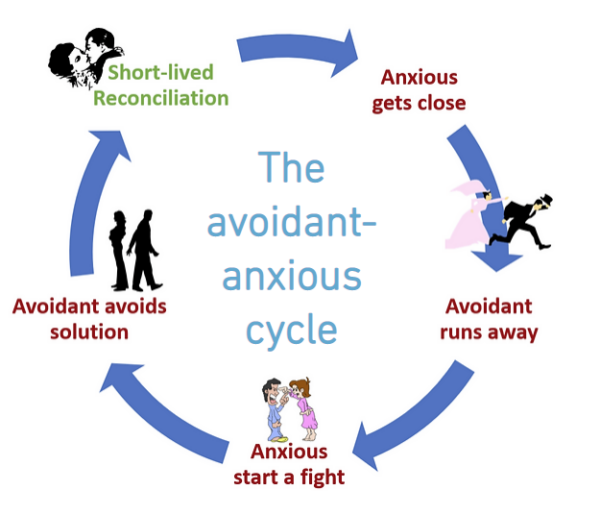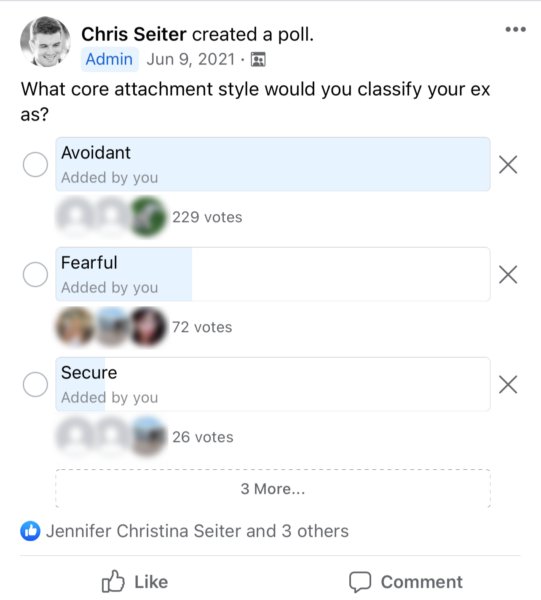Today we’re going to be talking about what can trigger a fearful avoidant to become either more anxious or avoidant. If you aren’t familiar,
A person who has a fearful avoidant attachment style is someone who contains both core wounds of an anxious and avoidant attachment style. So, a fearful avoidant has a deep seated fear of being abandoned but also can have moments where they fear they’ll lose their independence in relationships.
Now, after studying individuals with this attachment style we’ve actually been able to come up with a list of five things that will trigger them.
- A Breakup Can Trigger Their Anxious Side
- Being Taken Advantage Of In A Relationship
- Any Type Of Major Step Forward In A Relationship Can Trigger Their Avoidant Side
- Your Insecure Attachment Can Trigger Them
- Any Type Of Passive Aggressiveness From Their Partner
Let’s take a moment and talk about what each one of these things are in depth.

What Are Your Chances of Getting Your Ex Boyfriend Back?
Take the quizTrigger #1: Going Through A Breakup Initiated By You
Fearful avoidants are always the most difficult to diagnose and comprehend because really it’s like dealing with two opposing attachment styles in one.
In fact, one of our coaches, Tyler Ramsey, talks about this in an interview we did a few months ago,
Essentially the argument is that instead of having one “core wound” that explains their triggers a fearful avoidant will have two.
- The anxious one: a fear of being abandoned
- The avoidant one: a fear of losing independence
This makes them incredibly hard to diagnose because just when you think you are dealing with an avoidant something sets them off and triggers their anxious side and makes you rethink everything you think you know about them.
Since we have predominately studied breakups in the ten years we’ve been operating we can confidently say that this is often a trigger for them. However, usually this only occurs if you were the one to break up with them as it triggers their anxious side.
So, if you aren’t familiar this is my relationship life cycle wheel of death graphic,
Well specifically this is looking at how an avoidant handles themselves in relationships and then ultimately the post breakup period.
What’s interesting though is that it’s always assuming that the avoidant breaks up with you. The wheel would look a little different if you broke up with them.
Think of it like this.
As the wheel turns around as it stands,
It’s always them looking for an excuse to leave. However, what can happen is that sometimes a fearful avoidants main attachment style is the avoidant aspect and that avoidant aspect can actually prove to be too much for you which in turn causes you to want to leave the relationship.
So you do…
This is something they weren’t expecting and it triggers their anxious core wound. You’ve just abandoned them.
A fascinating paradox isn’t it?
Throughout the relationship it seemed that they were constantly holding you at an arms length. Finding every reason not to commit fully. To hold on to their independence. However, when that behavior proves to be too much for you to handle and you inevitably leave that triggers them and they start acting incredibly anxious.

What Are Your Chances of Getting Your Ex Boyfriend Back?
Take the quizWhich usually is when this occurs,
Basically on again/off again relationship.
Let’s move on to the next trigger.
Trigger #2: Being Taken Advantage Of In A Relationship
So, the thing to understand about fearful avoidants is that they are often stuck in this self destructive pattern where they are constantly taking advantage of themselves or putting themselves down.
- Constantly telling themselves that they aren’t good enough
- That they are unworthy of your love
- Punishing themselves for doing something wrong
So, when they date someone that essentially holds a mirror up to that behavior by literally telling them,
- They aren’t being good enough for you
- They are unworthy of your love
- Punishing them for doing something wrong
It can become excruciating and overload their system. What’s complicated about this is I’ve found that often it’s the anxious individuals who are saying this to the avoidant individuals.
So, often the anxious person gets triggered by the lack of effort from the avoidant and then literally tries to do anything to light a fire under them to show more commitment based behavior but instead all they end up doing is triggering the fearful avoidant even more.
Trigger #3: Any Type Of Major Step Forward In A Relationship Can Trigger Their Avoidant Side
I’ve been on record many times talking about the fact that our specialty is in studying exes who are avoidant. That’s our jam. That doesn’t mean we don’t know about anxious or fearful avoidant individuals.
It’s just we really know our stuff about what triggers avoidants.
After all, the majority of our clients are claiming that their exes are avoidant,
When studying what triggered avoidants we tended to notice that any type of major step forward in relationship can cause them to flee or withdraw.
What constitutes a major step forward in a relationship.
Well, here are real life situations that we have seen trigger an avoidant side,
- Becoming official in a relationship
- Talking about moving in together
- Talking about marriage
- Going ring shopping
- Actually moving in together
- Getting engaged
- Getting married
- Having a child together
- Buying a house together
Notice how each one of these “events” can irritate the major core wound of an avoidant. Each is a perceived threat on their independence.
Trigger #4: Your Own Insecure Attachment Can Trigger Them
This is where the psychology becomes really interesting.
A fearful avoidant will typically have a dominant attachment style and a secondary one BUT depending on your attachment style their dominant or secondary styles can switch.
Here’s a quick reference,
Anxious (You) triggers Avoidant (Them)
Avoidant (You) triggers Anxious (Them)
So, let’s once again pull up my wheel of death graphic when it comes to breakups,
This graphic is making a simple assumption.

What Are Your Chances of Getting Your Ex Boyfriend Back?
Take the quizIt’s making the assumption that you are anxious and your ex is avoidant. Notice how in phase three, where your ex starts to notice some worrying things it’s immediately followed with a phase where they think about leaving.
Well, the leap I’m trying to get you to make is that those “worrying things” are actually an avoidant picking up on your anxious behaviors which in turn causes their avoidant side to trigger.
But this wheel can work the opposite way as well.
Those “worrying things” could be you being avoidant which can cause them to pull harder to ensure the relationship works.
Just know that your attachment style has a huge impact on what side of a fearful avoidant gets triggered.
Trigger #5: Any Type Of Passive Aggressiveness From Their Partner
With trigger number two we talked about how fearful avoidants are in this constant war with themselves and that if you essentially “help” them be at war with themselves it can be a huge trigger for them.
Well, the only thing that may actually be worse than “helping them” in their self deprecating war is by being passive aggressive.
Why?
I think it’s because people that communicate that way are incongruous with their words and actions. They say (or don’t say) one thing and then do another which confuses the fearful avoidant and eventually they learn to cope by creating their own narrative about what you are thinking.
Anyone who has dealt with a fearful avoidant knows this is definitely on brand for them. They’ll literally create a worst case scenario delusion in their head about your intentions or thoughts because they have no clue what to think.
And it’s often difficult for you because when their anxious side causes them to blow up at you and they repeat this incorrect assumption out loud you can’t convince them that their thoughts are false.
They start to believe their own lie which in turn triggers them again and they end up in this loop of their own making that they can’t escape.
All from you simply being passive aggressive which I might add is a very avoidant symptom. So, in a way trigger #5 is like an extension of trigger #4 except worse because the fearful avoidant is literally using your inability to communicate effectively as a means to put themselves down and propagate a false reality.




Danni
August 16, 2022 at 10:04 am
Gosh … this has helped me so much reading this, brilliant research and so to the point. Many times I thought I was going cuckoo with a situation, but after reading this I’m relieved, mine wasn’t a one off situation I couldn’t understand, there must be others. Thank you!
bonny
June 11, 2022 at 12:05 pm
Hello to Chris and EBR team
Two weeks ago, I had a serious fight with my boyfriend over a very simple jealousy. Then he dumped me and blocked me on social networks and deleted my number from his phone because I can’t see his picture. We were together for 6 years and we had good days and we had common goals for our future. Once last year Something similar happened and we got back together by no contact and we had a good relationship for a year. I did NO CONTACT from the first day and I did not get any contact with him, I did not leave any post of myself. His birthday was a week after breakup, I continued to NO CONTACT and did not congratulate his birthday, Because I thought it might not answer me and he needs more space and time. All this time I read articles and books and tried to focus on myself and the reasons why the relationship got here. And I did the attachment style test and I did and my attachment style was fearful,
I enjoy that we loved each other very much but I was always afraid to make a mistake and hurt me. Now I know those fears were not real and related to my attachment style. My question is how can I get closer to a secure attachment style? My feelings go up and down like a roller coaster
bonny
June 8, 2022 at 8:50 am
Hello to Chris and EBR team
Two weeks ago, I had a serious fight with my boyfriend over a very simple jealousy. Then he dumped me and blocked me on social networks and deleted my number from his phone because I can’t see his picture. We were together for 6 years and we had good days and we had common goals for our future. Once last year Something similar happened and we got back together by no contact and we had a good relationship for a year. I did NO CONTACT from the first day and I did not get any contact with him, I did not leave any post of myself. His birthday was a week after breakup, I continued to NO CONTACT and did not congratulate his birthday, Because I thought it might not answer me and he needs more space and time. All this time I read articles and books and tried to focus on myself and the reasons why the relationship got here. And I did the attachment style test and I did and my attachment style was fearfull,
I enjoy that we loved each other very much but I was always afraid to make a mistake and hurt me. Now I know those fears were not real and related to my attachment style. My question is how can I get closer to a secure attachment style? My feelings go up and down like a roller coaster.